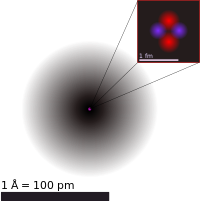
Photo from wikipedia
While core–shell nanomaterials are highly desirable for realizing enhanced optical and catalytic properties, their synthesis with atomic‐level control is challenging. Here, the synthesis and crystal structure of [Au12Ag32(SePh)30]4−, the first… Click to show full abstract
While core–shell nanomaterials are highly desirable for realizing enhanced optical and catalytic properties, their synthesis with atomic‐level control is challenging. Here, the synthesis and crystal structure of [Au12Ag32(SePh)30]4−, the first example of selenolated Au–Ag core–shell nanoclusters, comprising a gold icosahedron core trapped in a silver dodecahedron, which is protected by an Ag12(SePh)30 shell, is presented. The gold core strongly modifies the overall electronic structure and induces synergistic effects, resulting in high enhancements in the stability and near‐infrared‐II photoluminescence. The Au12Ag32 and its homometal analog Ag44, show strong interactions with oxygen vacancies of TiO2, facilitating the interfacial charge transfer for photocatalysis. Indeed, the Au12Ag32/TiO2 exhibits remarkable solar H2 production (6810 µmol g−1 h−1), which is ≈6.2 and ≈37.8 times higher than that of Ag44/TiO2 and TiO2, respectively. Good stability and recyclability with minimal catalytic activity loss are additional features of Au12Ag32/TiO2. The experimental and computational results reveal that the Au12Ag32 acts as an efficient cocatalyst by possessing a favorable electronic structure that aligns well with the TiO2 bands for the enhanced separation of photoinduced charge carriers due to the relatively negatively charged Au12 core. These atomistic insights will motivate uncovering of the structure–catalytic activity relationships of other nanoclusters.
Journal Title: Advanced Materials
Year Published: 2023
Link to full text (if available)
Share on Social Media: Sign Up to like & get
recommendations!